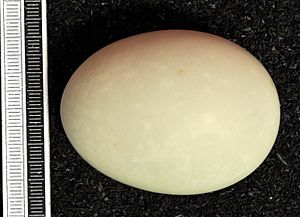Barrow's goldeneye facts for kids
Quick facts for kids Barrow's goldeneye |
|
|---|---|
 |
|
| Immature, female | |
| Conservation status | |
| Scientific classification | |
| Genus: |
Bucephala
|
| Species: |
islandica
|
 |
|
The Barrow's goldeneye (Bucephala islandica) is a type of medium-sized sea duck. It belongs to a group of ducks called goldeneyes. This bird was named after Sir John Barrow. Its scientific name, Bucephala, comes from Ancient Greek words meaning "bullheaded". This describes the duck's round head shape. The word islandica means it comes from Iceland.
Contents
What Does the Barrow's Goldeneye Look Like?
Adult Barrow's goldeneyes look a lot like the common goldeneye. Male adults are about 19.2 in (49 cm) long. They weigh around 2.13 lb (970 g). Females are usually 17 in (43 cm) long and weigh about 1.31 lb (590 g). Their wings can spread up to 27.6 to 28.7 inches (70 to 73 cm) wide.
Male Barrow's goldeneyes have a dark head with a purplish shine. They also have a white crescent shape on the front of their face. Female adults usually have a bill that is mostly yellow.
How They Differ from Common Goldeneyes
Male Barrow's goldeneyes are different from male common goldeneyes. Common goldeneyes have round white patches on their face. They also have less black on their back and a greenish shine. Their bill is also larger.
For females, the common goldeneye has a less round head. Only the tip of their bill is yellow.
What Sounds Do They Make?
The Barrow's goldeneye is a fairly quiet bird. They usually only make sounds during their breeding season. These sounds can be soft squeaks, grunts, and croaks. When they fly, their fast wing movements create a low whistling sound.
Where Do Barrow's Goldeneyes Live?
These ducks breed in wooded lakes and ponds. They are mostly found in northwestern North America. You can also find them in some parts of eastern Canada and Iceland.
Female ducks return to the same breeding spots every year. They also tend to use the same nesting places. Males stay with their mates through the winter. They defend their territory during the breeding season. Then, they leave for a special molting site. Mating pairs often stay together even if they are apart for a long time during the summer. They meet up again in their winter homes.
In Iceland, this bird is called húsönd (house-duck). It is common around Lake Mývatn in the northern part of the country.
How Do Barrow's Goldeneyes Behave?
Barrow's goldeneyes are migratory birds. This means they travel to different places for winter. Most of them spend winter in protected coastal waters or open inland waters. They use urban coastal areas as important stops during their long journeys. These places offer great spots for them to rest and feed in winter.
They are very rarely seen in western Europe or southern North America.
What Do They Eat?
These ducks are diving birds. They search for food underwater. They eat water insects, small crustaceans, and plants from ponds. Two main foods in their diet are Gammarus oceanicus and Calliopius laeviusculus. Both of these are small sea creatures. Mussels and snails also make up a big part of their diet.
Nesting and Territory
The Barrow's goldeneye is known as an "arboreal" bird. This means they often nest in holes found in old trees. They might also nest in burrows or safe spots on the ground.
Barrow's goldeneyes usually do not share their living areas with the more common goldeneye. They can be quite protective of their territory. This is especially true for the male ducks. They might fight if other birds come into their space. Male ducks often perform special displays along the edges of their territory. This happens both on land and in the water. These displays can last about 6 minutes and often cause other males to do their own show.
How Do Barrow's Goldeneyes Reproduce?
We don't know much about where and how Barrow's goldeneyes breed. After the breeding season, the birds fly to special molting sites. Molting is when they lose their old feathers and grow new ones. During this time, they cannot fly for about 20 to 40 days. These molting sites are often wetlands that have plenty of food. They are also less affected by dry weather, people, or predators.
The 1989 Exxon Valdez Oil Spill
The Barrow's goldeneye was greatly affected by the Exxon Valdez oil spill in 1989. This oil spill happened in their wintering areas. The number of these birds in those areas went down after the spill. The ducks were mainly exposed to the oil in the shallow water mussel beds along the coast.
Gallery
See also
 In Spanish: Porrón islándico para niños
In Spanish: Porrón islándico para niños






